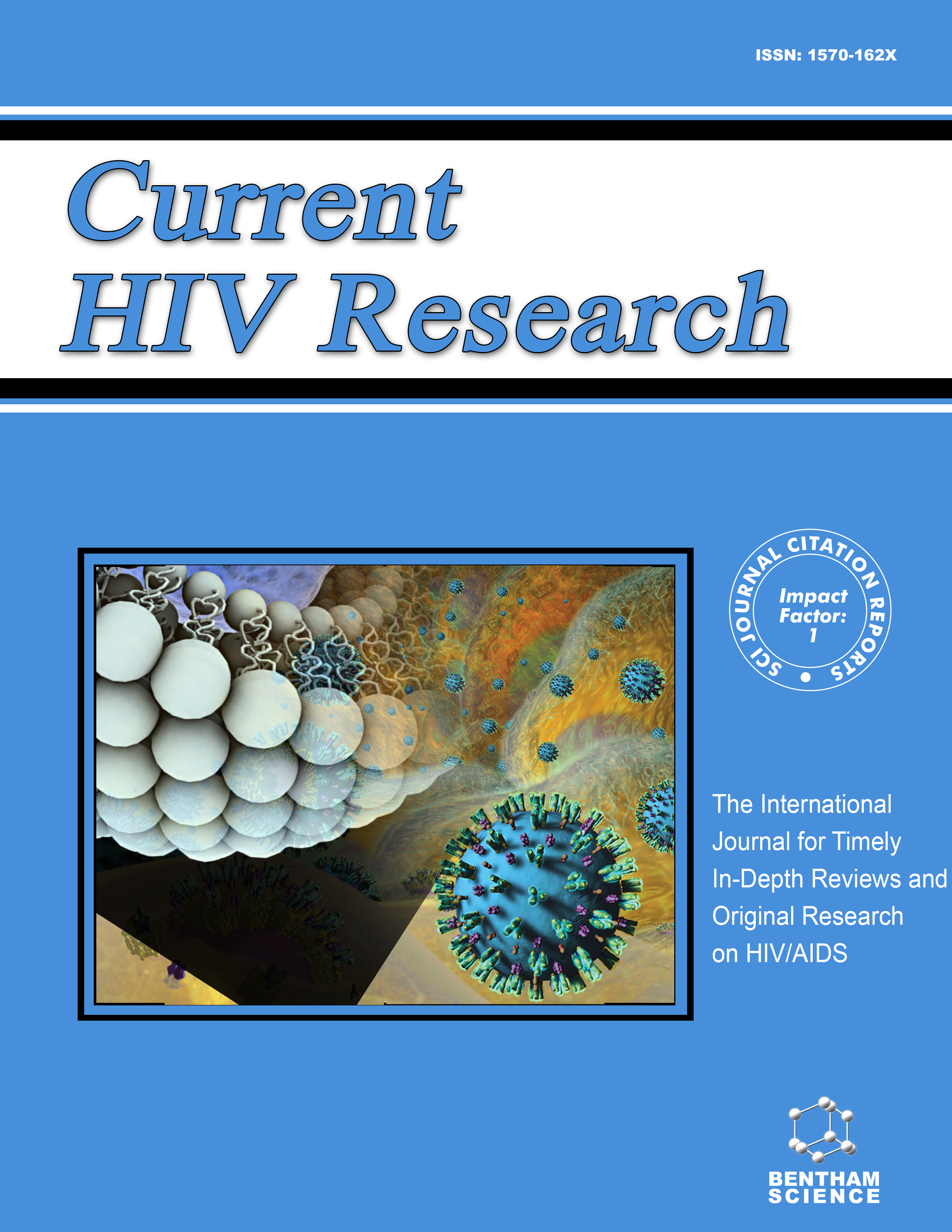- Home
- A-Z Publications
- Current HIV Research
- Previous Issues
- Volume 12, Issue 4, 2014
Current HIV Research - Volume 12, Issue 4, 2014
Volume 12, Issue 4, 2014
-
-
Editorial (Thematic Issue: Impact of Alcohol on HIV Related Issues in Human Population or Model System)
More LessBy Anil KumarAlcohol abuse and AIDS remain two of the leading public health problems, not only in the United States but throughout the world. Approximately amongst 5% of the total US population, abuses alcohol and this statistic has been fairly consistent during recent years. However, the prevalence of alcohol abuse among HIV-positive individuals has been estimated to be between 29 and 60% in the US [1]. Alcohol use has also been im Read More
-
-
-
Alcohol Abuse and HIV Infection: Role of DRD2
More LessAccording to a survey from the HIV Cost and Services Utilization Study (HCSUS), approximately 53% of HIV-infected patients reported drinking alcohol and 8% were classified as heavy drinkers. The role of alcohol as a risk factor for HIV infection has been widely studied and recent research has found a significant association between heavy alcohol consumption and lower levels of CD4 T cells among HIV-infected alcoholics. Al Read More
-
-
-
Chronic Alcohol Abuse and HIV Disease Progression: Studies with the Non-Human Primate Model
More LessAuthors: Angela M. Amedee, Whitney A. Nichols, Spencer Robichaux, Gregory J. Bagby and Steve NelsonThe populations at risk for HIV infection, as well as those living with HIV, overlap with populations that engage in heavy alcohol consumption. Alcohol use has been associated with high-risk sexual behavior and an increased likelihood of acquiring HIV, as well as poor outcome measures of disease such as increased viral loads and declines in CD4+ T lymphocytes among those living with HIV-infections. It is difficult to discern Read More
-
-
-
Brain Derived Neurotrophic Factor and Cognitive Status: The Delicate Balance Among People Living with HIV, with and without Alcohol Abuse
More LessIntroduction: The advent of combination antiretroviral therapy(cART) has lead to a significant reduction in morbidity and mortality among people living with HIV(PLWH). However, HIV-associated neurocognitive disorders (HAND) still remain a significant problem. One possible mechanism for the persistence of these disorders is through the effect of HIV on brain-derived neurotrophic factor (BDNF). BDNF is influenced by various fa Read More
-
-
-
Biomedical Consequences of Alcohol Use Disorders in the HIV-Infected Host
More LessAuthors: Patricia E. Molina, Gregory J. Bagby and Steve NelsonAlcohol abuse is the most common and costly form of drug abuse in the United States. It is well known that alcohol abuse contributes to risky behaviors associated with greater incidence of human immunodeficiency virus (HIV) infections. As HIV has become a more chronic disease since the introduction of antiretroviral therapy, it is expected that alcohol use disorders will have an adverse effect on the health of HIV-infect Read More
-
-
-
Differences in Sexual Risk Behaviors Between Lower and Higher Frequency Alcohol-Using African-American Adolescent Females
More LessBackground: To examine differences between lower and higher frequency alcohol users in sexual behaviors and psychosocial correlates of risk for HIV among young African-American females. Methods: Data were collected from sexually active African-American females aged 15-20 years, seeking services at a STD clinic in Atlanta, GA, to assess sexual behavior, correlates of risk, and a non-disease biological marker of unpr Read More
-
-
-
HIV-1, HCV and Alcohol in the CNS: Potential Interactions and Effects on Neuroinflammation
More LessAuthors: Peter S. Silverstein, Santosh Kumar and Anil KumarApproximately 25% of the HIV-1 positive population is also infected with HCV. The effects of alcohol on HIV-1 or HCV infection have been a research topic of interest due to the high prevalence of alcohol use in these infected patient populations. Although it has long been known that HIV-1 infects the brain, it has only been a little more than a decade since HCV infection of the CNS has been characterized. Both viruses are capable Read More
-
-
-
Exploring the Relationship of Functional Network Connectivity to Latent Trajectories of Alcohol Use and Risky Sex
More LessAlcohol use is a major risk factor associated with unprotected sexual behavior, leading to higher risk of sexually transmitted infections (STI) including the human immunodeficiency virus (HIV). Emerging largely crosssectional data suggest functional network connectivity strength is associated with problematic alcohol use, and as evidence supports a relationship between risky sexual behaviors and alcohol use, we hy Read More
-
-
-
Alcohol Enhances HIV Infection of Cord Blood Monocyte-Derived Macrophages
More LessAuthors: Dimitrios S. Mastrogiannis, Xu Wang, Min Dai, Jieliang Li, Yizhong Wang, Yu Zhou, Selin Sakarcan, Juliet Crystal Pena and Wenzhe HoAlcohol consumption or alcohol abuse is common among pregnant HIV+ women and has been identified as a potential behavioral risk factor for the transmission of HIV. In this study, we examined the impact of alcohol on HIV infection of cord blood monocyte-derived macrophages (CBMDM). We demonstrated that alcohol treatment of CBMDM significantly enhanced HIV infection of CBMDM. Investigation of the mechanisms of alco Read More
-
Volumes & issues
-
Volume 23 (2025)
-
Volume 22 (2024)
-
Volume 21 (2023)
-
Volume 20 (2022)
-
Volume 19 (2021)
-
Volume 18 (2020)
-
Volume 17 (2019)
-
Volume 16 (2018)
-
Volume 15 (2017)
-
Volume 14 (2016)
-
Volume 13 (2015)
-
Volume 12 (2014)
-
Volume 11 (2013)
-
Volume 10 (2012)
-
Volume 9 (2011)
-
Volume 8 (2010)
-
Volume 7 (2009)
-
Volume 6 (2008)
-
Volume 5 (2007)
-
Volume 4 (2006)
-
Volume 3 (2005)
-
Volume 2 (2004)
-
Volume 1 (2003)
Most Read This Month
Article
content/journals/chr
Journal
10
5
false
en


